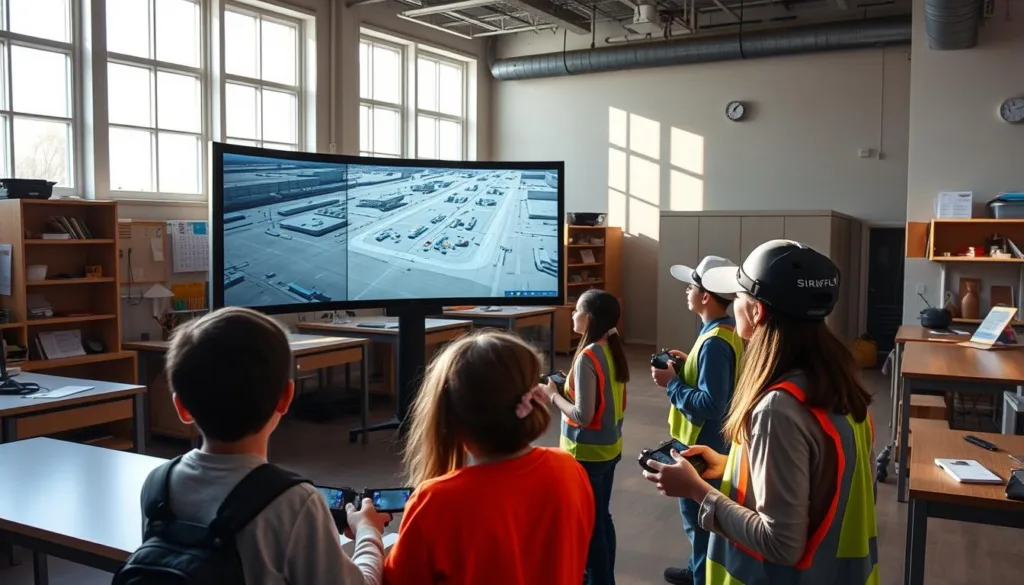Schools across America are embracing tools that bridge classroom learning with real-world technical skills. With the commercial drone sector projected to nearly double to $17 billion by 2028, forward-thinking educators are equipping learners with expertise applicable across 12+ industries – from agriculture to emergency response.
Simulation platforms now allow institutions to teach complex flight operations without expensive equipment or safety concerns. These systems replicate real-world scenarios while letting students master controls through immediate feedback. One Colorado school district reported 94% improvement in operational confidence after implementing virtual training modules.
The value proposition extends beyond technical mastery. Learners develop critical thinking through problem-solving exercises that integrate physics, coding, and spatial reasoning. Recent graduates with these qualifications are commanding $50+ hourly wages in fields like infrastructure inspection and media production.
Modern solutions make advanced technical education accessible regardless of school budgets. Cloud-based platforms eliminate hardware costs while maintaining certification-ready training standards. This democratization helps create diverse talent pipelines for industries facing skilled worker shortages.
Key Takeaways
- Virtual training tools reduce costs and risks compared to physical drone practice
- Multiple industries now seek operators with certified technical expertise
- Simulation platforms improve skill retention through interactive learning
- Integrated programs develop both technical and critical thinking abilities
- Accessible solutions help schools overcome budget and space limitations
- Graduates enter high-paying roles across growing tech sectors
Innovative Drone Flight Simulation in STEM Education
Next-gen simulation platforms are redefining hands-on learning in aviation technology courses. These virtual environments let learners master complex maneuvers through instant feedback loops, creating muscle memory faster than traditional methods. Institutions using these tools report 80% faster skill acquisition compared to physical aircraft training.
Real-World Training Without Real-World Risks
Leading platforms like SkyOp’s simulator replicate wind patterns and equipment failures with startling accuracy. Students practice emergency landings and precision navigation in scenarios mirroring FAA certification requirements. One Midwest technical college saw certification pass rates jump 40% after implementing virtual training modules.
Bridging Theory and Practice
Web-based solutions such as CodeMyDrones transform abstract concepts into tangible experiences. Learners code flight patterns while seeing immediate results in simulated environments. This approach strengthens spatial reasoning and problem-solving abilities – crucial for careers in aerial photography and infrastructure inspection.
Modern software adapts to various learning paces, providing personalized challenges while tracking progress through detailed analytics. Educators gain tools to identify skill gaps early, ensuring every participant builds confidence before handling physical equipment.
Benefits of Adopting a STEM Drone Curriculum
Educational institutions are discovering how immersive tech programs create pathways to tomorrow’s workforce. By blending interactive learning with career-ready skill-building, these initiatives prepare youth for fields where innovation outpaces traditional textbooks.

Cost-Effective and Risk-Free Training
Schools no longer need hangars or expensive equipment to teach aviation principles. Virtual platforms like those from SRIZFLY provide authentic flight experiences at 10% of traditional costs. One district saved $78,000 annually while maintaining FAA-aligned training standards.
Educators emphasize the value of mistake-friendly practice. “My class troubleshoots engine failures daily without worrying about crashes,” shares a Texas teacher. This safe space accelerates mastery – 83% of participants demonstrate operational readiness faster than peers using physical aircraft.
Boosting Student Engagement and Skills
Hands-on programs spark curiosity that ripples across subjects. A recent study showed 72% improvement in physics comprehension among participants.
“This program transformed how we approach problem-solving,”
notes an Oregon educator whosestudentsnow lead coding clubs.
Key advantages include:
- Real-time feedback builds spatial reasoning during navigation challenges
- Team projects develop communication abilities needed in tech careers
- Progress tracking helps instructors personalize learning paths
As industries evolve, schools leveraging these tools position graduates at the forefront of emerging fields. The proof? 94% of program alumni pursue STEM-related college majors or certifications.
Cutting-Edge Drone Flight Simulators for Effective Training
Advanced simulation technologies are transforming how piloting skills are taught in schools. Platforms like SRIZFLY’s virtual systems let learners master aerial maneuvers through realistic interfaces that mirror professional equipment. Students practice with authentic controls used in industries ranging from cinematography to infrastructure inspection.
Hands-On Experience Without Real Flight Risks
Modern simulators recreate challenging scenarios like equipment failures and harsh weather. SkyOp’s systems feature programmable failsafes and radio tethering, letting instructors instantly override controls. “Our class practices emergency landings daily without worrying about crashes,” shares a Utah educator.
These tools help learners build muscle memory using models like DJI’s Mavic 2 and Phantom 4 Pro. Immediate feedback loops track progress in navigation accuracy and response times. Schools report 60% faster skill development compared to traditional methods.
Key benefits include:
- Zero-risk environments for practicing complex maneuvers
- Instructor controls that maintain classroom safety
- Performance analytics to personalize learning paths
By eliminating physical risks, institutions can focus resources on perfecting essential skills. Graduates enter the workforce ready to operate advanced systems with confidence.
Empowering Educators with Comprehensive Drone Education Tools
Modern teaching platforms simplify complex skill development through smart resource organization. Cloud-based systems like SkyOp’s electronic textbook give instructors ready-to-use materials while maintaining flexibility for personalized instruction.

Cloud-Based Courseware and Instructor Resources
Dual-access portals separate learner materials from teacher tools. The instructor side includes automated grading, presentation slides, and troubleshooting guides. Educators can focus on mentoring rather than material preparation.
Real-time progress tracking helps identify skill gaps early. One Virginia school reported 89% faster intervention times using these analytics. “The system shows exactly where learners struggle,” notes a program coordinator.
| Feature | Traditional Methods | Cloud Platform |
|---|---|---|
| Curriculum Updates | Annual textbook revisions | Weekly content improvements |
| Assessment Tools | Manual grading | Instant quiz results |
| Accessibility | Classroom-only materials | Any device, any location |
| Support Options | Limited office hours | 24/7 live guidance |
Ongoing professional development keeps teaching methods current. LocoRobo’s team provides live coaching sessions and custom program adjustments. This ensures every class stays aligned with industry needs.
Want to explore how these solutions can enhance your technical program? Our team specializes in creating tailored implementation plans for schools nationwide.
Integrating a STEM drone curriculum in Your High School Program
Forward-thinking schools are transforming technical education through adaptable learning models. Custom-built programs merge classroom theory with market-ready skills, creating pathways that benefit both learners and local industries.
Customized Curriculum for Academic Success
Leading platforms like SkyOp’s 400-hour program demonstrate how tailored instruction works. Schools choose modules matching their resources – from basic flight principles to advanced mapping software. “Our rural district focuses on agricultural applications,” shares a Georgia teacher. Students master NDVI analysis for crop monitoring while meeting state science standards.
| Traditional Programs | Modern Technical Training |
|---|---|
| Fixed semester schedules | Flexible summer/weekend options |
| General STEM courses | Industry-specific skill development |
| Textbook-based learning | Cloud-based simulation tools |
| Graduation-focused | Career certification preparation |
Extending Training into Career Opportunities
Technical programs create immediate earning potential while building college-ready skills. Graduates often secure $50/hour roles in:
- Aerial surveying for construction firms
- Environmental monitoring teams
- Media production crews
SRIZFLY’s simulation tools let learners practice 3D modeling without equipment costs. One California school reported 78% of participants landing paid internships before graduation. As industries evolve, these programs ensure education stays two steps ahead.
Aligning Drone Training with Real-World Industry Standards
Preparing learners for commercial aviation demands requires aligning classroom instruction with strict industry benchmarks. Programs now integrate certification requirements directly into lesson plans, ensuring graduates meet employer expectations from day one.
FAA Part 107 Test Preparation and Regulations
Leading platforms like SkyOp build FAA Part 107 test prep into their courses. Students master airspace classifications and weather analysis through interactive modules mirroring actual exam scenarios. These tools help learners retain critical knowledge while understanding safety regulations governing commercial operations.
Bridging Classroom Learning with Commercial Careers
SRIZFLY’s simulation systems let aspiring professionals practice advanced maneuvers used in cinematography and infrastructure inspection. “Our graduates enter the workforce already familiar with industry-grade equipment,” notes a Florida instructor whose students secured drone pilot roles within weeks of certification.
By combining virtual training with career-focused skill development, schools create direct pathways to high-demand fields. This approach ensures technical education remains relevant in our fast-paced world – where adaptability determines professional success.
FAQ
How does drone flight simulation prepare students for real-world piloting?
Advanced simulators replicate real-flight physics and scenarios, allowing learners to practice maneuvers, troubleshoot issues, and build confidence in a controlled environment. This reduces risks while developing critical decision-making abilities.
What career pathways can high schoolers explore through this program?
Beyond piloting, students gain exposure to fields like aerial photography, surveying, agriculture tech, and public safety. Training also covers foundational knowledge for FAA Part 107 certification, which is required for commercial operations.
Are there resources to help teachers unfamiliar with aviation tech?
Yes! Cloud-based platforms provide ready-to-use lesson plans, video tutorials, and progress-tracking tools. Many programs also offer educator workshops to simplify implementation.
How does this align with current industry standards?
Courses integrate FAA regulations, safety protocols, and software used in professional settings. This ensures learners develop skills directly applicable to internships, certifications, or entry-level roles.
Can schools with limited budgets still adopt this training?
Affordable simulator software and free open-source tools lower entry barriers. Some programs also partner with grants or tech companies to provide equipment access.
What safety measures are taught alongside flight skills?
Students learn airspace rules, emergency procedures, and ethical considerations like privacy laws. These lessons emphasize responsible innovation and compliance with federal guidelines.



